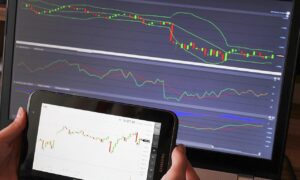Trading forex is a global pursuit, and one that can be done 24 hours a day during the working week. While this makes forex a highly attractive market due to the level of access and availability, it also poses its own question. Figuring out the best time of day to trade so that you can enter and exit positions requires a detailed knowledge of the mechanics of the global market. In this guide, we’re going to look at the key considerations that need to be made so that you can figure out when and where to trade.
When Should You Trade?
Forex markets only close for trading on the weekends, meaning you have 5 days of uninterrupted trading opportunities during the week. This type of continuous reading is possible because of the multiple venues that trade forex around the world, and understanding how they relate to one another is essential.
We can define forex trading sessions by four major market sessions, namely Sydney, Tokyo, London, and New York. There are then hybrid sessions throughout the 24-hour cycle when two forex trading sessions overlap. An example of this is the 4-hour overlap between the London and New York sessions. Making the overlaps a key part of a global forex strategy is essential.
Overlaps generally offer the most liquidity as the largest number of traders are active in the market. With a greater volume of trades comes a tendency towards greater pressure, which then causes larger price shifts. It’s these periods of relative volatility where many forex traders choose to focus their attention.
The Volatility of the London Session
The majority of institutional forex traders view the London session as amongst the most volatile and certainly the most liquid. London is still seen as the centre of the global forex market for a variety of reasons, such as the fact that it has a very large volume of trades and its geographical position. The London session can take any economic waves that started gaining momentum in Tokyo and Sydney and then amplify them and send them on to New York.
Volatility during the London session generally peaks during the 4-hour overlap with New York that occurs during the second half of the trading window in the UK. A rapid increase in trading volume, particularly centred on trends that impact the relative value of the US dollar, can cause sizeable price movements. Many forex traders will build this daily overlap into their strategy so that they can react to the impact of the opening of the New York session.
The Liquidity of the New York Session
The highly liquid nature of the opening of the New York session is driven by the large number of US-based traders and the overlap with the London session. Traders who are aware of the typical behaviour of the most historically volatile forex pairswill understand when and how to enter and exit the market during the New York session. Many will adopt positions in the first half of the session that they then look to exit during the second half, while at the same time trading on much shorter timeframes.
Adopting a multi-timeframe forex strategy can derisk the overall trading portfolio by protecting the trading capital from one-off changes and spikes in demand. The idea here is to capitalise on the movements that occur when the London session closes in a way that doesn’t overexpose the trading portfolio. Many forex traders will also look to adopt a variety of contrasting positions during the session so that they set themselves up for the opening of the Tokyo session.
The Opening Impact of the Tokyo Session
Traders who use platforms such as ThinkMarkets will be familiar with the sudden increase in market volatility that occurs the moment the Tokyo session opens. In many ways, the Tokyo session sets the tone for the following 24-hour trading cycle as economic data from Japan and China begins to be factored into trading decisions. Anyone who focuses on trading the Tokyo session will be aware of this fact, as well as how traders focusing on other sessions will be queuing up strategies during the second half of the session.
While it would be natural to focus solely on the impact of the opening of the Sydney session, as it is the next to begin, the real impact comes from London and New York. This is because these two sessions tend to attract significantly higher trading volumes and therefore, create higher volatility, as traders in different locations react to the economic reports from Asia.
The Fall in Institutional Activity During the Sydney Session
Although there is certainly a large volume of institutional trading when the Sydney and Tokyo sessions overlap, traders tend to see this type of activity fall after the close of the Tokyo session. For this reason, the Sydney session will tend to have lower trading volumes than the other three sessions, making pressure and momentum more nuanced and potentially harder to profit from. That said, many traders choose to develop Sydney-specific strategies for this very reason.
Adopting positions that favour the sudden mass influx of trades that begins with the opening of the London session is a common approach here. Traders who do so are using the Sydney session to set themselves up for the higher-volume sessions that follow, with the aim of using Asian and Australian market data to get ahead. They will typically look for pairs that show the greatest potential to move, but not necessarily those that are moving the most right now.
The Interlinked Nature of Sessions
Forex trading is a global pursuit and one that continues uninterrupted for five days. By its very nature, this means that the four sessions are components of a global market, rather than isolated markets that exist on their own terms. Understanding how one session influences another is certainly important, but it is equally important to make sure that the sessions don’t take on a mind of their own within a given strategy.
The most successful traders use their understanding of the global economy to use each session as an indicator of what may happen in the next session. For example, if a government policy announced in Asia looks set to apply downward pressure on shipping and manufacturing, this is likely to be felt in London and New York due to the global nature of Western supply chains.
Yes, it is too simple to think that only European traders work during the London session and that Americans are the only ones active in New York, but there will certainly be a bias that needs to be taken into account. Understanding this inherent bias can help traders secure returns from the market based on a global perspective.
The Predictability of Hours
Although the behaviour of no market is 100% predictable, the timing of the overlaps of the forex sessions is predefined. This means that traders can build their strategies around these key periods of greater liquidity, volume, and volatility. Doing so requires a careful analysis of how economic data is transmitted around the world and how traders are likely to interpret it in relation to currency pairs. By viewing forex as the result of a global macroeconomic puzzle, successful traders are able to frequently adopt positions that put them in a position to secure returns.



































